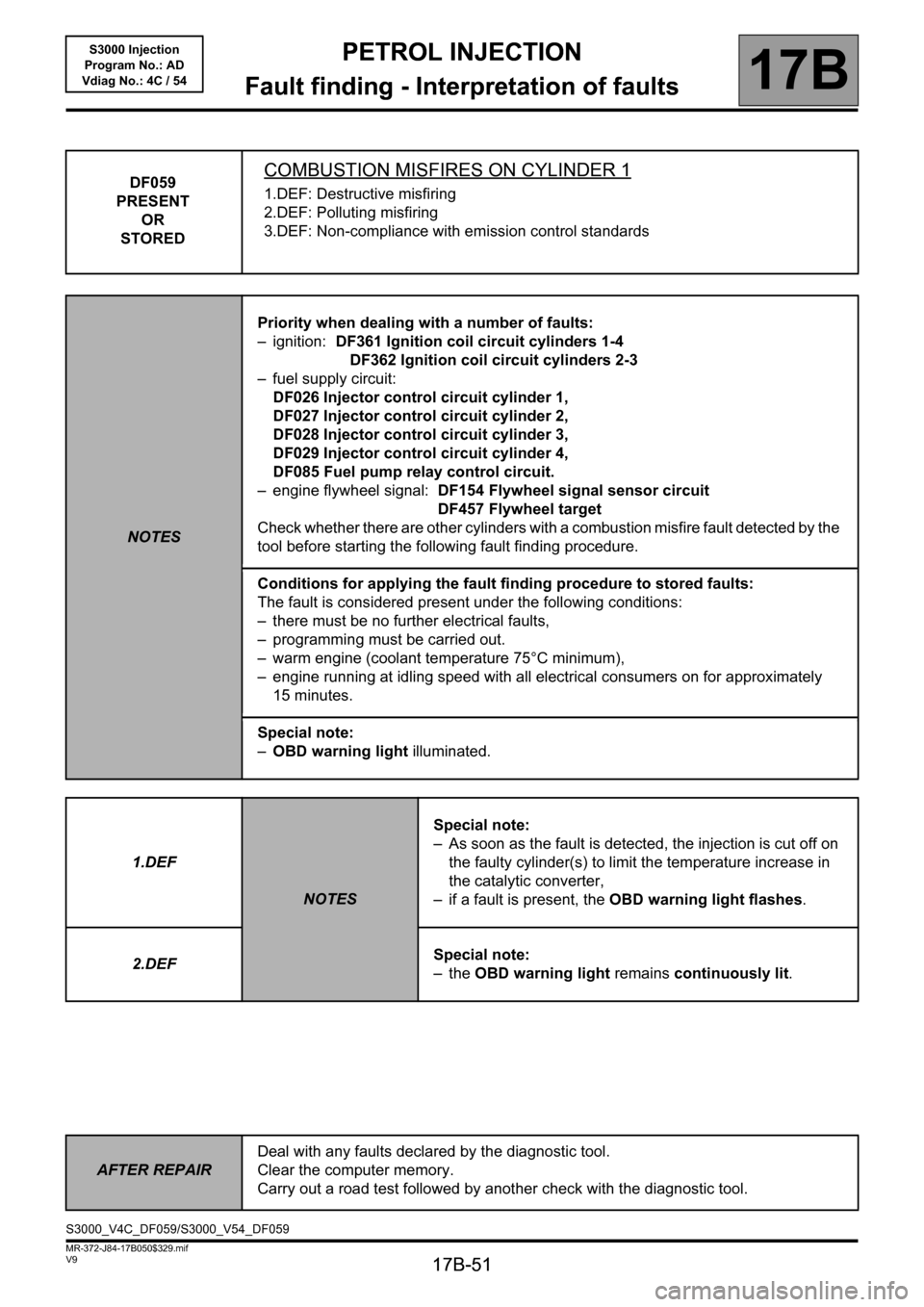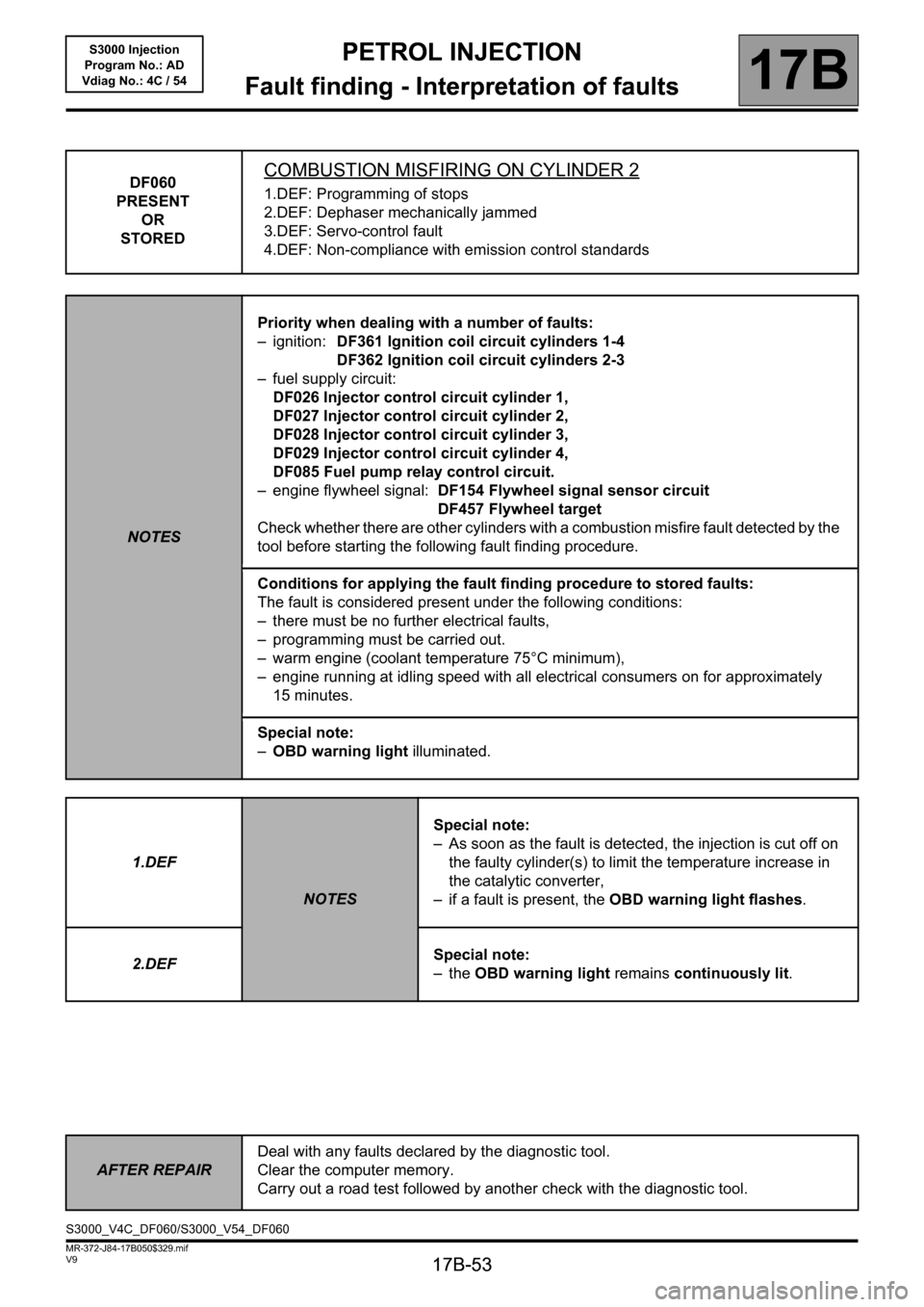engine coolant RENAULT SCENIC 2010 J95 / 3.G Petrol Injection S3000 Injection Workshop Manual
[x] Cancel search | Manufacturer: RENAULT, Model Year: 2010, Model line: SCENIC, Model: RENAULT SCENIC 2010 J95 / 3.GPages: 230, PDF Size: 0.92 MB
Page 9 of 230

PETROL INJECTION
Fault finding - System operation
17B
17B - 9
PETROL INJECTION
Fault finding - System operation
17B
17B - 9V9 MR-372-J84-17B050$094.mif
S3000 Injection
Program No.: AD
Vdiag No.: 4C / 54
Camshaft dephaser
Its role is to modify the valve timing.
The camshaft dephaser is continuously variable in operation.
In applications without a camshaft sensor, the engine phasing is controlled by software. This is the case on engines
that do not have a camshaft dephaser.
This information can be displayed by reading configuration LC008 Camshaft dephaser.
A first strategy called "Memo phasing" is applied to phase the engine management on starting according to the data
recorded when the engine last stalled. Wait for the end of auto-feed (power latch and therefore this data being
saved) before disconnecting the computer.
Then, a second program confirms the first decision. It is based on torque analysis.
The injection computer actuates a camshaft dephaser that varies according to the engine:
–K4M engine
Continuous variable inlet camshaft dephaser between 0 and 43° of the crankshaft, controlled by a solenoid
valve supplied by an opening cycle ratio circuit through the injection computer.
–F4R and F4R-T engines
Inlet camshaft dephaser controlled by a solenoid valve with an all or nothing supply from the injection
computer.
Camshaft position sensor (non-LPG K4M only)
The role of the camshaft sensor is:
– to locate the computer cylinders so that the computer correctly synchronises the sequential injection,
– checks the position of the inlet camshaft.
Motorised throttle valve
The throttle valve carries out idling speed regulation and engine air intake modulation functions. It comprises an
electric motor and two throttle position potentiometers.
When the engine is idling, the throttle position is regulated according to the idling speed setpoint. This setpoint takes
into account the major power consumers (air conditioning) and operating conditions (air temperature and coolant
temperature).
Page 11 of 230

PETROL INJECTION
Fault finding - System operation
17B
17B - 11
PETROL INJECTION
Fault finding - System operation
17B
17B - 11V9 MR-372-J84-17B050$094.mif
S3000 Injection
Program No.: AD
Vdiag No.: 4C / 54
Adaptive idling speed correction:
Under normal warm operating conditions, the idling speed opening cycle ratio value PR091 Idling speed regulation
theoretical OCR varies between a high value and a low value to obtain the nominal idling speed.
After operating dispersion (running in, engine fouling, etc.), the opening cycle ratio value may be close to the high or
low values.
The adaptive correction PR090 Idling speed regulation programming value on the idling speed opening cycle
ratio compensates for the gradual variations in the engine's air requirement, by bringing the idling speed opening
cycle ratio back to an average nominal value.
This adjustment only takes effect if the coolant temperature is above 75 °C, 1 minute after starting the engine and
during the idle speed regulation phase.
Idling speed setpoint calculation:
The idling speed setpoint is given by parameter PR010 Idle speed regulation valve setpoint.
The idling speed regulation setpoint depends on the coolant temperature, the depollution programming, the climate
control requirements, the position of the gearbox selector, any power assisted steering action, the passenger
compartment heating resistors, the oil temperature (engine protection) and the electricity balance calculated by the
injection software (the engine speed is increased by 160 rpm maximum if the battery voltage remains below 12.7 V).
Richness management
For optimal operation of the catalytic converter, the richness must be maintained around 1.
Richness regulation is controlled by the upstream sensor. The sensor gives voltage according to the difference
between the partial oxygen pressures contained in the exhaust and a cavity filled with a reference mixture
(atmosphere).
As the partial oxygen pressure in the exhaust is representative of the richness, the voltage supplied to the computer
represents a Rich - Lean signal.
Adaptive richness correction:
In loop mode, the richness regulation corrects the injection duration in order to obtain a mixture which is as close as
possible to a richness of 1. The richness correction value PR138 Richness correction is close to 50 %, with limits
of 0 and 100 %.
The richness adaptive corrections PR143 Self-adapting richness gain and PR144 Self-adapting richness offset
are used to offset the injection mapping to centre richness regulation on 50 %.
Adaptive corrections take 50 % as an average value after computer initialisation (clearing the programming) and have
the following limit values:
Page 12 of 230

PETROL INJECTION
Fault finding - System operation
17B
17B - 12
PETROL INJECTION
Fault finding - System operation
17B
17B - 12V9 MR-372-J84-17B050$094.mif
S3000 Injection
Program No.: AD
Vdiag No.: 4C / 54
A vehicle is fitted with an upstream sensor if the configuration reading LC003 Upstream oxygen sensor is WITH.
For the upstream sensor to be operational very rapidly, it is heated. Sensor heating ET052 Upstream O
2 sensor
heating is only ACTIVE when the engine is running. It is disabled above 84 mph (140 km/h) or with the engine
under load.
The downstream sensor is also used for richness regulation via the double loop program. The way it works is to
characterise the condition of the upstream sensor and to compensate for any upstream sensor dynamic richness
drift.
The vehicle is fitted with a downstream sensor if the configuration reading LC004 Downstream oxygen sensor is
WITH.
For the double loop ET056 Double richness loop to be ACTIVE, the vehicle must be driven with the engine warm
for approximately 1 minute 30 seconds in the absence of no load conditions.
The downstream sensor is also heated. The command is not immediate when the engine is started.
ET053 Downstream O
2 sensor heating is ACTIVE after a time that depends on the latest coolant temperature with
the engine running and in the absence of no load conditions. The heating of the downstream sensor is deactivated
under 84 mph (140 km/h) or when the engine is under load.
There are several types of control depending on the sensor type:
●BOSCH LSH25/NTK 6L (6Ω)/DELPHI AFS128 (3 wires): Continuous control,
●BOSCH LSF 4.7 (known as PLANAR): Each time the engine is started, control is first executed by means
of an OCR (opening cycle ratio) type signal of 20 Hz in frequency for approximately 20 seconds then it
becomes continuous,
●BOSCH NTK 6L (3.3Ω): each time the engine is started, the control is continuous first for 15 seconds then
executed by an OCR (Opening Cycle Ratio) type signal with a 20 Hz frequency.
Management of turbocharging pressure (F4R Turbo only)
The turbocharging pressure is adjusted via the position of the pressure regulation valve (wastegate).
Principle
This pressure regulation valve, connected via a rod to the wastegate diaphragm, is operated by the injection
computer via a solenoid valve. This solenoid valve is normally open and is fitted to the inlet pipe between the air filter
and turbocharger inlet.
At rest (open position), this solenoid valve connects the turbocharger outlet (turbocharging pressure) and the
pressure regulation valve control diaphragm.
The turbocharging pressure affects the diaphragm directly, the pressure regulation valve (wastegate) opens and the
maximum possible pressure is approximately 1,350 mbar - 1,400 mbar, irrespective of the engine speed (minimum
turbocharging for the engine).
When the solenoid valve is controlled, the turbocharging pressure signal (taken at the turbocharger outlet) is
diverted to the compressor inlet. As a result, the diaphragm is not subject to turbocharging pressure, the pressure
regulation valve (wastegate) closes back to a position imposed by the regulation system.
Page 16 of 230

PETROL INJECTION
Fault finding - System operation
17B
17B - 16
PETROL INJECTION
Fault finding - System operation
17B
17B - 16V9 MR-372-J84-17B050$094.mif
S3000 Injection
Program No.: AD
Vdiag No.: 4C / 54
4. Engine coolant temperature management
Engine cooling is provided by 1 or 2 fan assemblies (depending on the vehicle layout). The injection computer
requests the UPC to actuate them via the multiplex network.
To provide cooling:
Engine running, GMV1 is requested when the coolant temperature exceeds 99 °C and stops when the coolant
temperature falls below 96 °C. GMV2 is requested when the coolant temperature exceeds 102 °C and stops when
the coolant temperature falls below 99 °C.
With the engine off, only fan assembly 1 may be activated to provide the anti-percolation function (if engine is
stopped when very hot). The anti-percolation function is active with the ignition off for a determined period. During
this period, fan assembly 1 is requested if the coolant temperature exceeds approximately 100 °C and is shut down
if the coolant temperature drops below around 95 °C.
If a fault is detected on the coolant temperature sensor circuit, then fan assembly 1 is requested to operate
continuously.
If the engine coolant temperature goes beyond the warning threshold of 11 8 ° C, the injection computer requests the
instrument panel computer via the multiplex network to illuminate on the coolant temperature warning light until the
coolant temperature falls back below 115 ° C.
In addition to the engine requirements, the injection computer centralises the cooling requirements for the Air
conditioning and BVA/BVR functions.
5. Air conditioning function
The S3000 computer manages a cold loop air conditioning system.
– air conditioning request via multiplex connection,
– acquisition of air conditioning circuit pressure,
– vehicle speed
– air conditioning compressor control,
– fan assembly control request by Protection and Switching Unit.
The injection computer recovers the power absorbed by the air conditioning compressor and the fast idling speed
request using the pressure acquired in the air conditioning circuit.
These signals are necessary for adapting the engine management (idling speed regulation, air flow correction, etc.),
for several reasons:
– air conditioning compressor efficiency,
– sturdier engine to torque bucking caused by compressor activation,
– helping the alternator.
Requests for fan assembly 1 and/or fan assembly 2 are recovered based on the air conditioning circuit pressure and
the vehicle speed. In short, the lower the speed and the higher the pressure, the greater the fan assembly requests.
Page 22 of 230

PETROL INJECTION
Fault finding - Allocation of computer tracks17B
17B - 22
17B
17B - 22V9 MR-372-J84-17B050$141.mif
S3000 Injection
Program No.: AD
Vdiag No.: 4C / 54
Connector (B), 48 tracks:
Track Description
A1 Injector 1 - control
A2 Injector 2 - control
A3 Injector 3 - control
A4 Injector 4 - control
B1 Not used
B2 Pinking sensor screening earth
B3 Pinking sensor + signal
B4 Pinking sensor - signal
C1 Not used
C2 Not used
C3 Engine speed (LPG) TDC - signal
C4 Not used
D1 Not used
D2 Not used
D3 Motorised throttle valve potentiometer gang 2 signal
D4 + Power latch relay feed output
E1 Turbocharging pressure sensor earth (F4RT 774 and 776 only)
E2 Air temperature sensor signal
E3 Air temperature sensor earth
E4 Position and engine speed sensor - signal (tooth signal)
F1 Turbocharging pressure sensor + signal (F4RT 774 and 776 only)
F2 Coolant temperature sensor + signal
F3 Engine speed and position sensor + signal (tooth signal)
F4 Coolant temperature sensor earth
G1 + 5 V turbocharging pressure sensor (F4RT 774 and 776 only)
G2 Motorised throttle potentiometer + 5 V feed
G3 Motorised throttle valve potentiometer gang 1 signal
G4 Motorised throttle valve potentiometers common earth
H1 Not used
H2 Manifold pressure sensor + 5 V feed
H3 Manifold pressure sensor + signal
H4 Manifold pressure sensor earth
Page 23 of 230

PETROL INJECTION
Fault finding - Allocation of computer tracks17B
17B - 23
17B
17B - 23V9 MR-372-J84-17B050$141.mif
S3000 Injection
Program No.: AD
Vdiag No.: 4C / 54
Connector (B), 48 tracks (continued):
Track Description
J1 Not used
J2 Refrigerant pressure + 5 V feed
J3 Refrigerant pressure + signal
J4 Not used
K1 Not used
K2 Refrigerant pressure sensor earth
K3 Multiplex line L2 engine connection (F4R 771 AUTO, K4M 813 AUTO and K4M 788 LPG only)
K4 Multiplex line H2 engine connection (F4R 771 AUTO, K4M 813 AUTO and K4M 788 LPG only)
L1 Power earth 1
L2 Not used
L3 Inlet camshaft dephaser control (non-LPG K4M only)
L4 Electric coolant pump control (F4RT 774 and 776 only)
M1 Power earth 2
M2 + Battery supply
M3 Motorised throttle valve + signal
M4 Motorised throttle valve - signal
Page 29 of 230

PETROL INJECTION
Fault finding - Configurations and programming17B
17B - 29
17B
17B - 29V9 MR-372-J84-17B050$235.mif
S3000 Injection
Program No.: AD
Vdiag No.: 4C / 54
2. PROGRAMMING
Programming the flywheel target
– Decelerate a first time with injection cut-off (i.e. feet off the brake, accelerator pedal and clutch pedals) between
3500 and 3000 rpm, in 3rd gear for a manual gearbox and 2nd for automatic transmission, for at least 5 seconds.
– Decelerate a second time with injection cut-off (i.e. feet off the brake, accelerator pedal and clutch pedals) between
2400 and 2000 rpm for K4 engines and between 1800 and 1400 rpm for R4R engines, in 3rd gear for a manual
gearbox and 2nd for automatic gearbox, for at least 5 seconds.
Check the programming using ET089 Flywheel target programming.
Programming the throttle end stops
When replacing the computer or the motorised throttle valve, with the ignition on, wait 30 seconds so that the
computer may program the MAX and MIN limits, then switch off the ignition and wait 30 seconds for the end of the
Power Latch, so that the computer may store the programmed limits.
Check the programming using ET051 Throttle stop programming.
* This is the moment when, during deceleration with no load, the engine drops to idling speed and recovers torque. LC158Air conditioning heating resistor management
→WITH
→NONE
LC162Controlled coolant thermostat
→WITH
→NONE
LC170Electric coolant pump
→WITH
→NONE
Page 33 of 230

PETROL INJECTION
Fault finding - Fault summary table
17B
17B-33
PETROL INJECTION
Fault finding - Fault summary table
17B
17B-33V9 MR-372-J84-17B050$282.mif
S3000 Injection
Program No.: AD
Vdiag No.: 4C / 54
Tool faultAssociated
DTC codeDescriptionLevel 2 fault
warning light
(Red brake
warning light)Level 1 fault
warning light
(Orange
injection
warning light)No warning
light onOBD
warning light
DF404 C302Automatic gearbox
or sequential
gearbox CAN
connection1.DEF/2.DEF/
3.DEF
DF410 C155Instrument panel
connection1.DEF
DF436 0300Detection of engine
misfiring1.DEF/
2.DEF
3.DEF
DF455 0460Low fuel level
signal1.DEF/2.DEF
DF457 0315 Flywheel target1.DEF/
2.DEF
DF570 2600COOLANT PUMP
RELAYCO/CC.0
CC.1
DF601 0135Upstream O
2
sensor heating
power circuitCO.0/CC.1
1.DEF
DF602 0141Downstream O
2
sensor heating
power circuitCO.0/CC.1
1.DEF
DF623 C315Closing brake
signal1.DEF
DF624 C111UPC multiplex
connection1.DEF
2.DEF
DF635 1301LPG cylinder 1
combustion misfire1.DEF
2.DEF
DF636 1302LPG cylinder 2
combustion misfire1.DEF
2.DEF
DF637 1303LPG cylinder 3
combustion misfire1.DEF
2.DEF
DF638 1304LPG cylinder 4
combustion misfire1.DEF
2.DEF
DF639 1300Combustion misfire
in LPG mode1.DEF
2.DEF
3.DEF
DF650 2299Accelerator pedal
position signal1.DEF
DF1070 0534 Cold loop
Page 51 of 230

PETROL INJECTION
Fault finding - Interpretation of faults
17B
17B-51
PETROL INJECTION
Fault finding - Interpretation of faults
17B
17B-51V9 MR-372-J84-17B050$329.mif
S3000 Injection
Program No.: AD
Vdiag No.: 4C / 54
DF059
PRESENT
OR
STOREDCOMBUSTION MISFIRES ON CYLINDER 1
1.DEF: Destructive misfiring
2.DEF: Polluting misfiring
3.DEF: Non-compliance with emission control standards
NOTESPriority when dealing with a number of faults:
– ignition: DF361 Ignition coil circuit cylinders 1-4
DF362 Ignition coil circuit cylinders 2-3
– fuel supply circuit:
DF026 Injector control circuit cylinder 1,
DF027 Injector control circuit cylinder 2,
DF028 Injector control circuit cylinder 3,
DF029 Injector control circuit cylinder 4,
DF085 Fuel pump relay control circuit.
– engine flywheel signal: DF154 Flywheel signal sensor circuit
DF457 Flywheel target
Check whether there are other cylinders with a combustion misfire fault detected by the
tool before starting the following fault finding procedure.
Conditions for applying the fault finding procedure to stored faults:
The fault is considered present under the following conditions:
– there must be no further electrical faults,
– programming must be carried out.
– warm engine (coolant temperature 75°C minimum),
– engine running at idling speed with all electrical consumers on for approximately
15 minutes.
Special note:
–OBD warning light illuminated.
1.DEF
NOTESSpecial note:
– As soon as the fault is detected, the injection is cut off on
the faulty cylinder(s) to limit the temperature increase in
the catalytic converter,
– if a fault is present, the OBD warning light flashes.
2.DEFSpecial note:
–the OBD warning light remains continuously lit.
AFTER REPAIRDeal with any faults declared by the diagnostic tool.
Clear the computer memory.
Carry out a road test followed by another check with the diagnostic tool.
S3000_V4C_DF059/S3000_V54_DF059
Page 53 of 230

PETROL INJECTION
Fault finding - Interpretation of faults
17B
17B-53
PETROL INJECTION
Fault finding - Interpretation of faults
17B
17B-53V9 MR-372-J84-17B050$329.mif
S3000 Injection
Program No.: AD
Vdiag No.: 4C / 54
DF060
PRESENT
OR
STOREDCOMBUSTION MISFIRING ON CYLINDER 2
1.DEF: Programming of stops
2.DEF: Dephaser mechanically jammed
3.DEF: Servo-control fault
4.DEF: Non-compliance with emission control standards
NOTESPriority when dealing with a number of faults:
– ignition: DF361 Ignition coil circuit cylinders 1-4
DF362 Ignition coil circuit cylinders 2-3
– fuel supply circuit:
DF026 Injector control circuit cylinder 1,
DF027 Injector control circuit cylinder 2,
DF028 Injector control circuit cylinder 3,
DF029 Injector control circuit cylinder 4,
DF085 Fuel pump relay control circuit.
– engine flywheel signal: DF154 Flywheel signal sensor circuit
DF457 Flywheel target
Check whether there are other cylinders with a combustion misfire fault detected by the
tool before starting the following fault finding procedure.
Conditions for applying the fault finding procedure to stored faults:
The fault is considered present under the following conditions:
– there must be no further electrical faults,
– programming must be carried out.
– warm engine (coolant temperature 75°C minimum),
– engine running at idling speed with all electrical consumers on for approximately
15 minutes.
Special note:
–OBD warning light illuminated.
1.DEF
NOTESSpecial note:
– As soon as the fault is detected, the injection is cut off on
the faulty cylinder(s) to limit the temperature increase in
the catalytic converter,
– if a fault is present, the OBD warning light flashes.
2.DEFSpecial note:
–the OBD warning light remains continuously lit.
AFTER REPAIRDeal with any faults declared by the diagnostic tool.
Clear the computer memory.
Carry out a road test followed by another check with the diagnostic tool.
S3000_V4C_DF060/S3000_V54_DF060